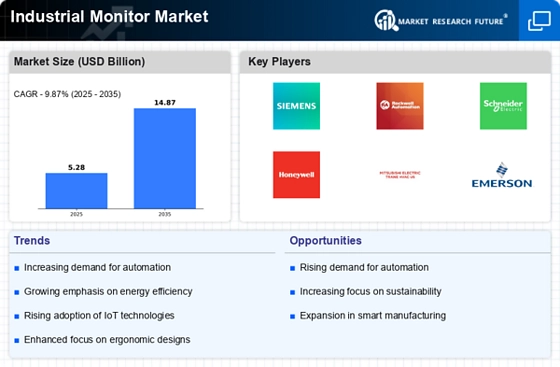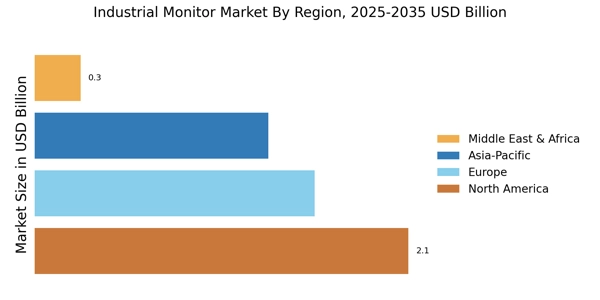Rising Demand for Automation
The Industrial Monitor Market is experiencing a notable surge in demand for automation across various sectors. As industries strive for enhanced efficiency and productivity, the integration of automated systems becomes paramount. This trend is particularly evident in manufacturing, where the need for real-time monitoring and control is critical. According to recent data, the automation market is projected to grow at a compound annual growth rate of approximately 9% over the next five years. This growth directly influences the Industrial Monitor Market, as advanced monitors are essential for overseeing automated processes, ensuring optimal performance, and minimizing downtime. Consequently, manufacturers are increasingly investing in high-quality industrial monitors that can withstand harsh environments while providing accurate data. The interplay between automation and industrial monitoring is likely to shape the future landscape of the market.
Increased Focus on Safety and Compliance
Safety and compliance are becoming increasingly critical in the Industrial Monitor Market, driven by stringent regulations and the need for risk mitigation. Industries such as oil and gas, pharmaceuticals, and food processing are under constant scrutiny to adhere to safety standards. Industrial monitors play a vital role in ensuring compliance by providing real-time data and alerts regarding operational parameters. For example, monitors equipped with safety features can detect anomalies and trigger alarms, thereby preventing accidents and ensuring worker safety. The market for safety-related industrial equipment is projected to grow significantly, with a focus on integrating advanced monitoring solutions. This trend not only enhances operational safety but also fosters a culture of accountability within organizations. As a result, the demand for industrial monitors that prioritize safety and compliance is likely to rise, further propelling the market.
Sustainability and Environmental Considerations
Sustainability is becoming a pivotal concern within the Industrial Monitor Market, as organizations strive to minimize their environmental impact. The push for eco-friendly practices is leading to the development of energy-efficient monitors that consume less power and utilize sustainable materials. Industries are increasingly prioritizing sustainability in their procurement processes, seeking monitors that align with their environmental goals. Recent data suggests that the market for green technology in industrial applications is projected to grow significantly, with a focus on reducing carbon footprints. This shift towards sustainability not only meets regulatory requirements but also enhances corporate reputation. As a result, the demand for industrial monitors that are designed with sustainability in mind is likely to increase, reflecting a broader trend towards environmentally responsible practices in the industry.
Technological Advancements in Display Solutions
Technological advancements are significantly impacting the Industrial Monitor Market, particularly in display solutions. Innovations such as high-definition displays, touch screen interfaces, and enhanced connectivity options are becoming standard features in industrial monitors. These advancements not only improve user experience but also facilitate better data visualization and interaction with complex systems. For instance, the introduction of 4K resolution monitors is enabling operators to view intricate details, which is crucial in sectors like aerospace and automotive manufacturing. Furthermore, the market for industrial displays is expected to reach a valuation of over 5 billion dollars by 2026, indicating a robust growth trajectory. As industries continue to adopt cutting-edge technologies, the demand for sophisticated industrial monitors that can support these innovations is likely to escalate, thereby driving the market forward.
Growing Adoption of IoT in Industrial Applications
The Industrial Monitor Market is witnessing a growing adoption of Internet of Things (IoT) technologies, which are revolutionizing industrial applications. IoT-enabled monitors facilitate seamless connectivity and data exchange between devices, allowing for enhanced monitoring and control of industrial processes. This integration enables predictive maintenance, reducing downtime and operational costs. Recent studies indicate that the IoT market in industrial settings is expected to reach approximately 1 trillion dollars by 2025, underscoring the potential for growth in the Industrial Monitor Market. As industries increasingly recognize the benefits of IoT, the demand for monitors that can support these technologies is likely to escalate. This trend not only enhances operational efficiency but also provides valuable insights into performance metrics, thereby driving informed decision-making.


















Leave a Comment